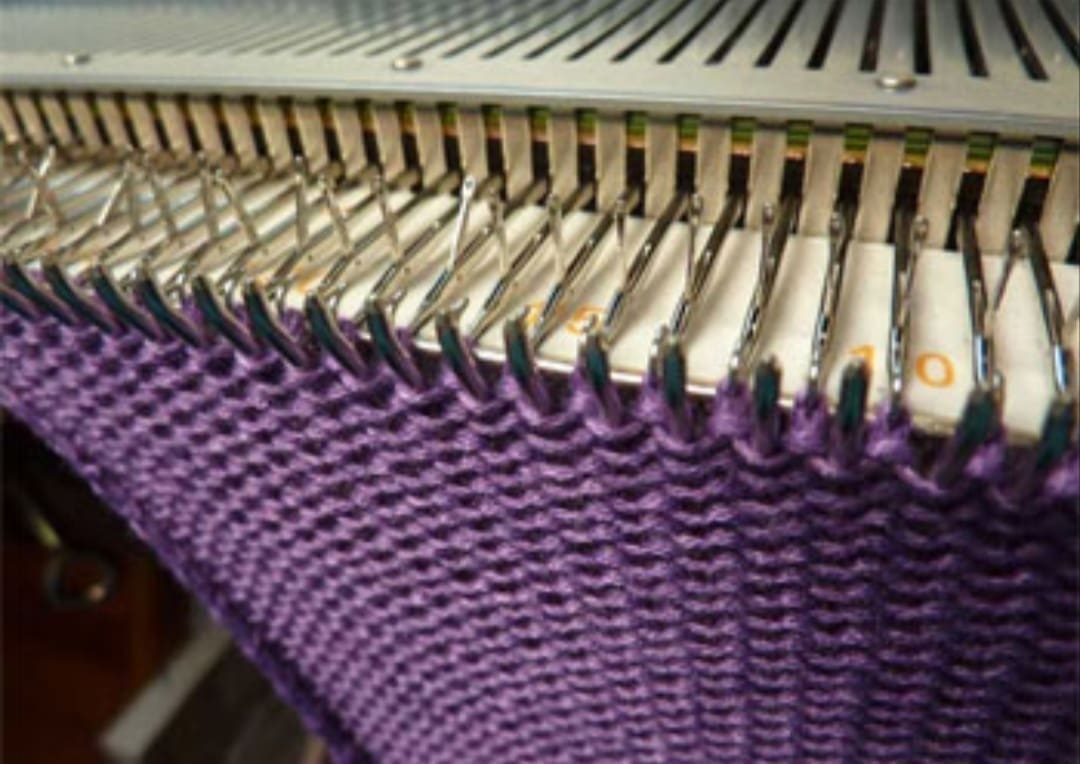A knitting machine is a device used to create knitted fabrics in a semi or fully automated fashion.
There are numerous types of knitting machines, ranging from simple spool or board templates with no moving parts to highly complex mechanisms controlled by electronics. All, however, produce various types of knitted fabrics, usually either flat or tubular, and of varying degrees of complexity. Pattern stitches can be selected by hand manipulation of the needles, or with push-buttons and dials, mechanical punch cards, or electronic pattern reading devices and computers.
Process:
Early flat bed stocking frames had low carbon steel bearded needles where the tips were reflexed and could be depressed onto a hollow closing the loop. The needles were supported on a needle bar (bed) that passed back and forth, to and from the operator. The beards were simultaneously depressed by a presser bar.
These are the basic 6 steps in knitting:

1. The needle bar goes forward- the open needles clear the web
2. The weft thread is laid on the needles
3. The weft thread falls loosely
4. The needle bar draws back, the weft is pulled in the open needles
5. The needle bar draws back, the presser bar drops, the needle loops close and the weft is drawn back through the web
6. The needles open, a new row has been added to the web which drops under gravity
This basic process can still be recognised in all machines, but it has been refined as new technologies have become available.
Types:
There are a lot of ways to classify knitting machines. Some sources have classified them according to its configuration such as either Flat Bed or Circular. In other references, it’s sorted according to its function; like for example, Fabric knitting Machines and Garment-Length knitting machines.
Indeed, there are many different types of knitting machines used for making many types of knitted fabrics.
Listed below is the classification of machines according to weft knitting machine and warp knitting machine.
Weft Knitting Machine:
Weft Knitting Machines are used to make weft knitted fabrics by just a single yarn. Knitting in weft is a more common method than warp knitting. In Weft knitting, the looms are knitted horizontally in a circular form from left to right of the fabric. Weft knits are made from a yarn fed into the circular knitting machine needles.
They are further classified as:
1. Circular Knitting Machine
A. Single Jersey Circular Knitting Machine
1. Plain Single Jersey
2. 2 Track 4 Track
3. Terry and Fleece
4. Jacquards
B. Double Jersey Circular Knitting Machine
1. Rib
2. Interlock
3. Pique
2. Straight Bar Knitting Machine
A. Single Needle Straight Bar Knitting Machine
B. Double Needle Straight Bar Knitting Machine
3. Flat Bar Knitting Machine
A. Flat Bed or V-Bed
B. Single-Bed
C. Unidirectional Bed
Warp Knitting Machine:
On the other hand, Warp knitting is done by knitting in a zigzag pattern along the fabric area. While weft knitting is done by knitting across the fabric, Warp knitting is accomplished by running knits through adjacent wales or columns.
They are further classified as:
1. Raschel Knitting Machine
2. Tricot Knitting Machine
Further these machines have various applications according to which they are used in the industry. Innovation has quickly transformed the growing capabilities of knitting machines in forming knitted fabrics and today, you can choose from a variety of knitting machines for your textile industry.
Reference:
Retrieved from https://www.xdknitmachinery.com/types-of-knitting-machines/
Knitting machine. (2020, March 18). Retrieved from https://en.m.wikipedia.org/wiki/Knitting_machine

